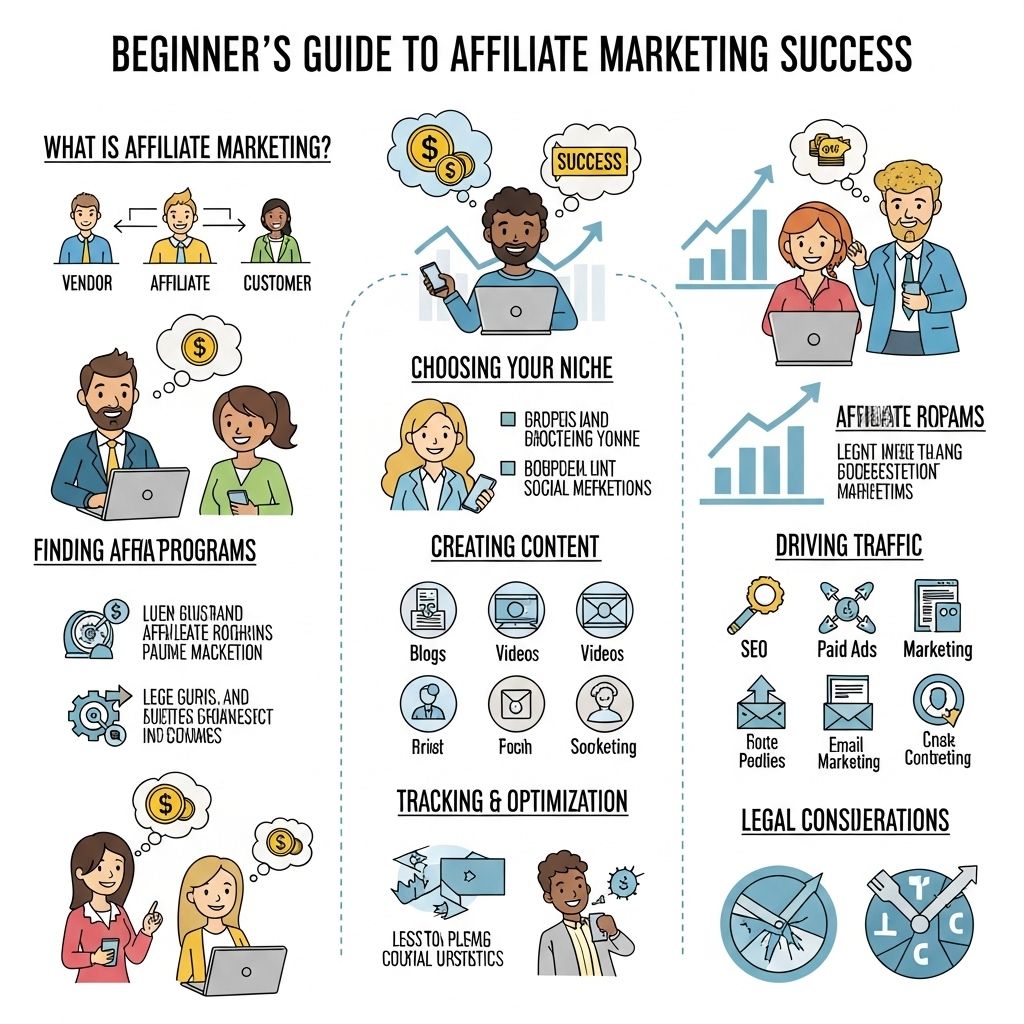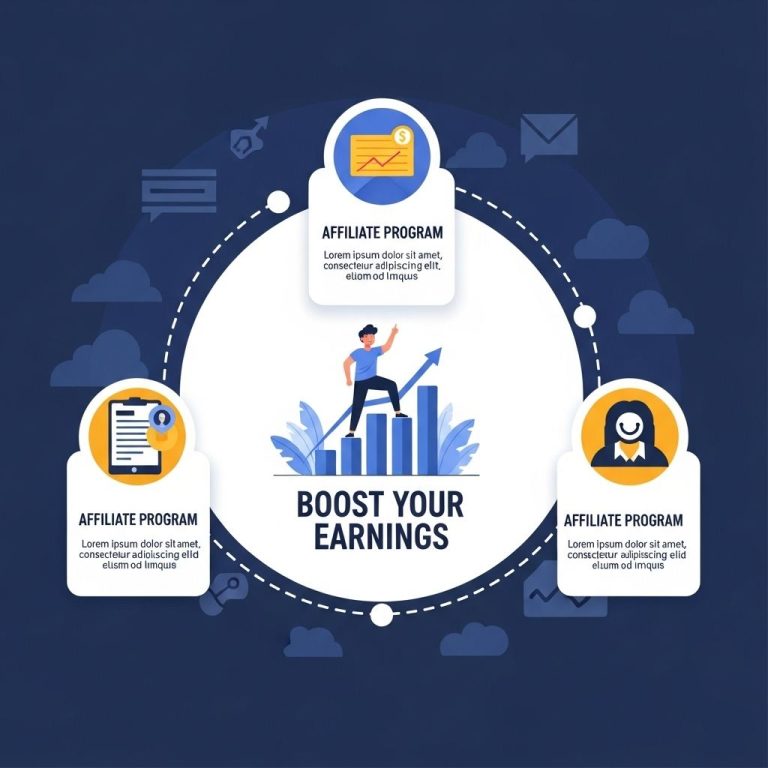In the rapidly evolving landscape of digital marketing, affiliate marketing stands out as a lucrative and accessible venture for both novice and seasoned marketers. This performance-based model allows individuals to earn a commission by promoting products or services from various companies, making it a viable option for anyone looking to generate passive income online. This guide will delve into the essentials of affiliate marketing, providing actionable insights and strategies to help you set yourself up for success.
Understanding Affiliate Marketing
At its core, affiliate marketing involves three primary players: the merchant, the affiliate, and the consumer. Here’s a breakdown of each role:
- Merchant: Also known as the creator or brand, this is the company that offers products or services to be sold.
- Affiliate: This is the individual or entity that promotes the merchant’s products in exchange for a commission.
- Consumer: The end user who purchases the product through the affiliate’s marketing efforts.
When a consumer makes a purchase through an affiliate’s unique referral link, the affiliate earns a commission based on the sale.
Choosing Your Niche
Selecting a niche is a critical step in your affiliate marketing journey. A well-defined niche not only helps you target a specific audience but also positions you as an authority in that area. Consider the following factors when choosing your niche:
Personal Interest and Expertise
Choose a niche that aligns with your interests and knowledge. This ensures that you will remain engaged and motivated to produce content. For instance:
- If you are passionate about fitness, consider promoting health supplements and workout gear.
- If technology excites you, affiliate marketing for software or gadgets might be suitable.
Market Demand
Research the market demand for your chosen niche. Use tools like Google Trends, SEMrush, or Ahrefs to assess the popularity and competition level. Aim for:
- A niche with a steady demand.
- Moderate competition to ensure you can break through the noise.
Finding Affiliate Programs
Once you have defined your niche, the next step is to find suitable affiliate programs. Here are some popular affiliate networks and platforms:
| Affiliate Network | Main Features |
|---|---|
| Amazon Associates | Wide-ranging products; user-friendly interface; great for beginners. |
| ClickBank | Digital products; high commissions; diverse niches. |
| ShareASale | Variety of merchants; robust reporting tools; reputable. |
| CJ Affiliate | Large network; access to top brands; advanced tools. |
When evaluating affiliate programs, consider the following criteria:
- Commission structure (pay-per-sale, pay-per-click, etc.)
- Payment terms (minimum payout, payment methods)
- Product relevance to your audience
Building Your Platform
To effectively promote affiliate products, you need a platform to work with. Here are some options:
Creating a Blog
Blogging is one of the most popular ways to engage an audience and promote affiliate products. When creating a blog, keep these tips in mind:
- Choose a domain name: Select something memorable and relevant to your niche.
- Select a hosting provider: Consider hosting services like Bluehost or SiteGround.
- Design your blog: Make sure it’s visually appealing and easy to navigate.
Utilizing Social Media
Social media platforms are powerful tools for promoting affiliate products. Strategies for effective social media marketing include:
- Engaging regularly with your audience through posts and comments.
- Creating visually appealing content, such as infographics and videos.
- Using strategies like Instagram Stories or TikTok videos to showcase products dynamically.
Creating Quality Content
Content is king in the world of affiliate marketing. High-quality, valuable content attracts visitors and encourages them to act. Here are some content types to consider:
Product Reviews
In-depth product reviews help potential customers make informed decisions. Include:
- Honest pros and cons.
- Personal experience and insights.
- High-quality images or videos of the product in use.
How-to Guides
Creating guides that educate your audience on using a product can enhance credibility and trust. Consider these elements:
- Step-by-step instructions.
- Visual aids, like screenshots or diagrams.
- Links to the product within the content.
Driving Traffic
Once you’ve created your content, you need to drive traffic to your site. Here are techniques to increase visibility:
Search Engine Optimization (SEO)
Optimizing your content for search engines is essential. Focus on:
- Keyword research to identify relevant search terms.
- On-page SEO elements, such as meta tags and headings.
- Building backlinks to improve domain authority.
Paid Advertising
Investing in paid advertising can amplify your reach quickly. Platforms to consider include:
- Google Ads for keyword-targeted campaigns.
- Facebook Ads for targeted audience engagement.
- Instagram Ads for visually-driven products.
Tracking Your Success
To ensure your affiliate marketing efforts yield results, tracking your success is critical. Use analytics tools to monitor:
- Traffic sources and user behavior.
- Conversion rates for different products.
- Overall earnings and commissions over time.
Tools like Google Analytics and affiliate dashboard analytics provide valuable insights into your performance.
Scaling Your Affiliate Business
As you gain momentum, consider strategies to scale your affiliate business:
- Expanding to new niches or products.
- Collaborating with other affiliates for joint ventures.
- Investing in email marketing to build a subscriber list.
Scaling allows you to increase your earnings potential while diversifying your revenue streams.
Conclusion
Affiliate marketing presents a unique opportunity for individuals to generate income online, but it requires dedication, strategy, and continuous learning. By understanding the fundamentals, creating valuable content, and implementing effective marketing techniques, you can set yourself up for success in this dynamic field. Remember, persistence and adaptability are key in navigating the journey of affiliate marketing.
FAQ
What is affiliate marketing?
Affiliate marketing is a performance-based marketing strategy where an affiliate earns a commission for promoting a company’s products or services.
How do I start with affiliate marketing?
To start with affiliate marketing, choose a niche, join affiliate programs, create a platform like a blog or social media page, and begin promoting products.
What are the best affiliate programs for beginners?
Some of the best affiliate programs for beginners include Amazon Associates, ShareASale, and CJ Affiliate, as they offer a wide range of products and user-friendly platforms.
How do I drive traffic to my affiliate links?
You can drive traffic to your affiliate links through content marketing, social media, email marketing, and search engine optimization (SEO) strategies.
What are common mistakes to avoid in affiliate marketing?
Common mistakes to avoid include choosing the wrong niche, not disclosing affiliate links, neglecting SEO, and failing to engage with your audience.
How can I track my affiliate marketing performance?
You can track your affiliate marketing performance using analytics tools provided by affiliate programs, Google Analytics, and tracking links to monitor clicks and conversions.




